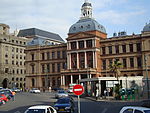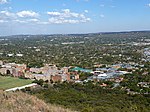Café Riche, Pretoria

Café Riche is on the corner of Parliament and WF Nkomo Streets, adjoining Church Square, Pretoria, South Africa. The building was designed by the Dutch architect Frans Soff and built in 1905. Soff also designed the National Women's Monument in Bloemfontein with Anton van Wouw. The building was originally known as the Investment Building, but due to Café Riche's popularity, the original name was forgotten. Café Riche is one of the oldest restaurants in Pretoria. The building was designed in the Art Nouveau style popular in Europe from 1894 to 1914. The stone owl on the concrete pedestal, as well as the artwork of 'Mercurius,' is also the work of Van Wouw. The window frames and doors came from the Toringkerk, the second and last church in Church Square with a tower. Café Riche was declared a Provincial Heritage Site and recognized under Article 34 of the National Heritage Resources Act (Law 25/1999), because it was over 60 years old.
Excerpt from the Wikipedia article Café Riche, Pretoria (License: CC BY-SA 3.0, Authors, Images).Café Riche, Pretoria
Church Street, Pretoria Tshwane Ward 60
Geographical coordinates (GPS) Address External links Nearby Places Show on map
Geographical coordinates (GPS)
| Latitude | Longitude |
|---|---|
| N -25.74669 ° | E 28.18724 ° |
Address
Café Riche
Church Street
0126 Pretoria, Tshwane Ward 60
Gauteng, South Africa
Open on Google Maps









